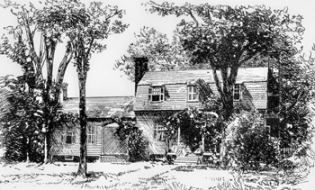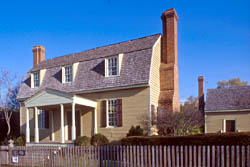Lane, Joel
ca. 1740–29 Mar. 1795
 Joel Lane, legislator, Revolutionary Patriot, planter, and vendor to the state of the land on which the capital was established, was born presumably in Halifax (then Edgecombe) County, the son of Joseph and Patience McKinne Lane. His father is thought to have been a grandson of Richard Lane of Jamestown, Va., first of the name in America and, according to tradition, a kinsman of Ralph Lane, first governor of North Carolina. His mother was a daughter of Colonel Barnabas McKinne, provincial justice and colonial assemblyman.
Joel Lane, legislator, Revolutionary Patriot, planter, and vendor to the state of the land on which the capital was established, was born presumably in Halifax (then Edgecombe) County, the son of Joseph and Patience McKinne Lane. His father is thought to have been a grandson of Richard Lane of Jamestown, Va., first of the name in America and, according to tradition, a kinsman of Ralph Lane, first governor of North Carolina. His mother was a daughter of Colonel Barnabas McKinne, provincial justice and colonial assemblyman.
In the early 1760s, Joel Lane was a justice of the peace for Halifax County. In April 1761 he was appointed sheriff by Governor Arthur Dobbs, who in July named him captain of a Halifax regiment of foot under Colonel Alexander McCulloch. Extant documents list him as a citizen of Halifax as late as July 1768. By August 1769, however, he had apparently settled near Walnut Creek in that portion of Johnston County that became Wake, where he acquired several thousand acres of land. In November he was commissioned a justice of the Johnston County Court.
As representative from Johnston to the 1770–71 General Assembly, Lane introduced the bill creating Wake County, effective 12 Mar. 1771. Named a commissioner to run the Wake boundaries, he also served on the commission to choose sites for and erect the new county courthouse, prison, and stocks. These were built near his home, still standing at 728 West Hargett Street, Raleigh, slightly southwest of its original site. Wake's first county court is thought to have convened at Lane's home on 4 June 1771. From that date until his death he was a member of that court, serving from time to time as presiding justice. During those years he was licensed to operate an ordinary at his home, apparently a well-known stopping place for travelers along main roads crossing in the vicinity. From 25 May 1772 until June 1777 he was register of Wake, evidently also serving for a year as Chatham County clerk of court. For most of the period 1778–79, he was entry taker for Wake. He represented Wake in the 1773 General Assembly, where he sat on the committee on public accounts.
 On 19 Jan. 1771 Governor William Tryon appointed Lane lieutenant colonel of Wake militia under his father-in-law, Colonel John Hinton. The unit did not participate in the Battle of Alamance, rather being left at home, according to Tryon's journal, "to prevent the disaffected in [Wake] from forming into a Body and Joining the Regulators in the adjacent Counties." Theophilus Hunter succeeded him in the military post in about 1773. Lane was a Wake delegate to the Provincial Congress at Hillsborough in August 1775 and at Halifax in April 1776, although he apparently was not seated at Halifax. During the Revolution he was a commissioner for obtaining and distributing salt. The 1776 Council of Safety adjourned in late August to Lane's home, where the General Assembly also met from 23 June to 14 July 1781 in addition to using the Wake courthouse.
On 19 Jan. 1771 Governor William Tryon appointed Lane lieutenant colonel of Wake militia under his father-in-law, Colonel John Hinton. The unit did not participate in the Battle of Alamance, rather being left at home, according to Tryon's journal, "to prevent the disaffected in [Wake] from forming into a Body and Joining the Regulators in the adjacent Counties." Theophilus Hunter succeeded him in the military post in about 1773. Lane was a Wake delegate to the Provincial Congress at Hillsborough in August 1775 and at Halifax in April 1776, although he apparently was not seated at Halifax. During the Revolution he was a commissioner for obtaining and distributing salt. The 1776 Council of Safety adjourned in late August to Lane's home, where the General Assembly also met from 23 June to 14 July 1781 in addition to using the Wake courthouse.
Lane was a senator from Wake County in eleven of the fourteen sessions of the General Assembly from 1782 through 1794. He was a member of the 1788 and 1789 constitutional conventions, the latter ratifying the U.S. Constitution and the former issuing the ordinance calling for a permanent state capital to be established within ten miles of Isaac Hunter's plantation in Wake. The commission on location appointed by the 1792 Assembly spent eight days in March at Lane's home while examining various tracts of land offered for sale. From these they selected Lane's tract of one thousand acres, on which they laid out the city of Raleigh the same year. Its western boundary was within a few hundred yards of his home and the Wake courthouse. During the last six years of his life, Lane served on the first board of trustees for The University of North Carolina and was one of those offering land for its site.
Lane was married twice, both times to daughters of Colonel John Hinton of Wake. Between their marriage on 9 Dec. 1762 and her death on 9 Sept. 1771, he and Martha Hinton Lane had three sons: Henry, James, and William. With her sister Mary, he had nine more children: Nancy, John, Martha, Elizabeth, Mary, Thomas, Dorothy, Joel Hinton, and Grizelle. Descendants include members of the Moses Mordecai family who gave that name to Raleigh's Mordecai House, the original portion of which was the home of Lane's son Henry and his wife Mary, granddaughter of Colonel Hinton. Governor and University of North Carolina President David Lowry Swain was Lane's grandnephew (grandson of Lane's brother Jesse), as was General Joseph Lane of Oregon, hero of the Mexican War and Oregon's first governor and U.S. senator. A nephew of Martha and Mary Hinton Lane, Hinton James, was the first student to enter The University of North Carolina, 12 Feb. 1795.
The deaths of Joel and Mary Lane occurred less than a week apart, Mary having survived her husband only five days when she died on 3 Apr. 1795. A small burial ground, believed to be the Lane family cemetery on South Boylan Avenue, Raleigh, was excavated in 1969, and those remains thought to be Joel Lane's were reinterred on 30 Mar. 1973 in Raleigh's City Cemetery. The Joel Lane House was acquired in 1927 by the Wake Committee of the National Society of the Colonial Dames of America in the State of North Carolina for preservation. Designated a Raleigh Historic Site, it is also listed in the National Register of Historic Places.
References:
Chatham County Court Records, Johnston County Court Minutes, North Carolina Troop Returns of 8 May 1771, Report of Committee Establishing Capitol [sic ], and Wake County Court Minutes (North Carolina State Archives, Raleigh).
John L. Cheney, Jr., ed., North Carolina Government, 1585–1974 (1974).
Walter Clark, ed., State Records of North Carolina, vols. 19–21 (1901–3).
R. D. W. Connor, A Documentary History of the University of North Carolina, 1776–1799, vol. 1 (1953).
Marshall De Lancey Haywood, Joel Lane: Pioneer and Patriot (1900).
Journal of the House of Commons of North Carolina, 17 Dec. 1770.
Laws of North Carolina, 1770 .
George W. Mordecai Papers (Southern Historical Collection, University of North Carolina, Chapel Hill).
William L. Saunders, ed., Colonial Records of North Carolina, vols. 8–9 (1890).
Additional Resources:
The Joel Lane House: http://www.joellane.org/
Joel Lane House, National Park Service: https://www.nps.gov/nr/travel/raleigh/lan.htm
Haywood, Marshall De Lancey. Joel Lane, pioneer and patriot. a biographical sketch, including notes about the Lane family and the colonial and revolutionary history of Wake County, North Carolina. Raleigh, N.C. Alford, Bynum & Christophers. 1900. https://archive.org/details/joellanepioneerp00hayw (accessed April 22, 2013).
"Joel Lane House." N.C. Highway Historical Marker H-2, N.C. Office of Archives & History. https://www.ncdcr.gov/about/history/division-historical-resources/nc-highway-historical-marker-program/Markers.aspx?sp=Markers&k=Markers&sv=H-2 (accessed April 22, 2013).
Joel Lane House, Learn NC: http://www.learnnc.org/lp/pages/2059
Joel Lane house, floor plans, in NCSU Rare and Unique Digital Collections: http://d.lib.ncsu.edu/collections/catalog/bh006702702
Search results for "Joel Lane" in Library of Congress Prints & Photographs Online Collection:http://www.loc.gov/pictures/search/?q=joel%20lane&sg=true
Search results for 'Joel Lane' in NCDCR Collections [including several photos of interior and exterior of Joel Lane House]: http://collections.ncdcr.gov/RediscoveryProficioPublicSearch/WordSearch....
Randall, William George, 1860-1905. Colonial residence, Raleigh N.C. built by Joel Lane. 1900. (accessed April 22, 2013).
North Carolina ECHO (Project). Joel Lane Museum House. 2002-04-30. https://digital.ncdcr.gov/Documents/Detail/joel-lane-museum-house/52032 (accessed April 22, 2013).
Battle, Kemp P. (Kemp Plummer), 1831-1919. Sketches of the early history of the city of Raleigh. Centennial address, fourth of July, 1876. Raleigh News Steam Job Print. 1877. https://digital.ncdcr.gov/Documents/Detail/sketches-of-the-early-history-of-the-city-of-raleigh.-centennial-address-fourth-of-july-1876/379545 (accessed April 22, 2013).
N.C. Division of Tourism, Film and Sports Development, Department of Commerce. Sheltering a heritage: North Carolina's historic buildings. [Raleigh, N.C. [N.C.]: Travel and Promotion Division, Department of Conservation and Development, 1969?]. 1969. https://digital.ncdcr.gov/Documents/Detail/sheltering-a-heritage-north-carolinas-historic-buildings/2533499 (accessed April 22, 2013).
North Carolina ECHO (Project). Joel Lane Museum House. 2002-04-30. https://digital.ncdcr.gov/Documents/Detail/joel-lane-museum-house/52025 (accessed April 22, 2013).
Image Credits:
This 1887 drawing is perhaps the earliest likeness of the Joel Lane House. North Carolina Collection, University of North Carolina at Chapel Hill Library.
Joel Lane House, available from the National Park Service. Available from https://www.nps.gov/nr/travel/raleigh/lan.htm (accessed April 22, 2013).
1 January 1991 | Reid, Elizabeth Davis